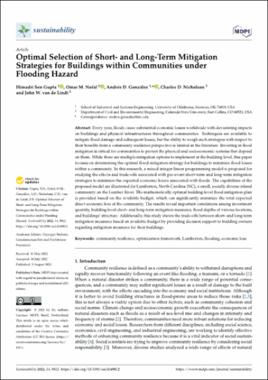| dc.contributor.author | Gupta, Himadri Sen | |
| dc.contributor.author | Nofal, Omar M. | |
| dc.contributor.author | González, Andrés D. | |
| dc.contributor.author | Nicholson, Charles D. | |
| dc.contributor.author | van de Lindt, John W. | |
| dc.date.accessioned | 2022-08-16T18:29:54Z | |
| dc.date.available | 2022-08-16T18:29:54Z | |
| dc.date.issued | 2022-08-09 | |
| dc.identifier.citation | Gupta, H. S., Nofal, O. M., González, A. D., Nicholson, C. D., & van de Lindt, J. W. (2022). Optimal selection of short- and long-term mitigation strategies for buildings within communities under flooding hazard. Sustainability, 14(16), 9812. https://doi.org/10.3390/su14169812 | en_US |
| dc.identifier.uri | https://hdl.handle.net/11244/336466 | |
| dc.description.abstract | Every year, floods cause substantial economic losses worldwide with devastating impacts on buildings and physical infrastructures throughout communities. Techniques are available to mitigate flood damage and subsequent losses, but the ability to weigh such strategies with respect to their benefits from a community resilience perspective is limited in the literature. Investing in flood mitigation is critical for communities to protect the physical and socioeconomic systems that depend on them. While there are multiple mitigation options to implement at the building level, this paper focuses on determining the optimal flood mitigation strategy for buildings to minimize flood losses within a community. In this research, a mixed integer linear programming model is proposed for studying the effects and trade-offs associated with pre-event short-term and long-term mitigation strategies to minimize the expected economic losses associated with floods. The capabilities of the proposed model are illustrated for Lumberton, North Carolina (NC), a small, socially diverse inland community on the Lumber River. The mathematically optimal building-level flood mitigation plan is provided based on the available budget, which can significantly minimize the total expected direct economic loss of the community. The results reveal important correlations among investment quantity, building-level short- and long-term mitigation measures, flood depths of various locations, and buildings’ structure. Additionally, this study shows the trade-offs between short- and long-term mitigation measures based on available budget by providing decision support to building owners regarding mitigation measures for their buildings. | en_US |
| dc.description.sponsorship | This research was partially funded by the National Institute of Standards and Technology (NIST) Center of Excellence for Risk-Based Community Resilience Planning through a cooperative agreement with Colorado State University [70NANB20H008 and 70NANB15H044]. This research was also partially funded by the National Science Foundation (NSF) through award 2052930. Article processing charge was partially provided by the University of Oklahoma Libraries’ Open Access Fund. | en_US |
| dc.language | en_US | en_US |
| dc.subject | Community Resilience | en_US |
| dc.subject | Optimization | en_US |
| dc.subject | Flooding | en_US |
| dc.subject | Lumberton | en_US |
| dc.title | Optimal Selection of Short-and Long-Term Mitigation Strategies for Buildings within Communities under Flooding Hazard | en_US |
| dc.type | Article | en_US |
| dc.description.peerreview | Yes | en_US |
| dc.identifier.doi | https://doi.org/10.3390/su14169812 | en_US |
| ou.group | Gallogly College of Engineering::School of Industrial and Systems Engineering | en_US |
